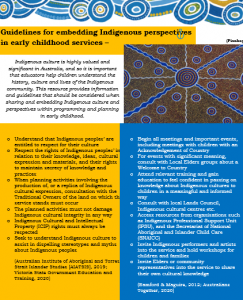15 Embedding Indigenous perspectives in early childhood services
Courtney McEwan
For non-Indigenous educators, it can often be confronting to embed Indigenous perspectives within programming and planning. There is the fear of getting it wrong or being tokenistic. The resource provides educators with information and guidelines on appropriate and respectful ways to share Indigenous culture and knowledge within early childhood settings. Educators should use this resource when incorporating and embedding Indigenous perspectives within programming and planning. The resource outlines the importance of respecting Indigenous rights regarding their knowledge, ideas, cultural expressions, and materials, as well as the importance of Indigenous Cultural and Intellectual Property rights (Australian Institute of Aboriginal and Torres Strait Islander Studies, 2019). The resource should be used throughout Early Childhood Education settings by all educators to ensure that a high level of respect and integrity for Indigenous culture and heritage is upheld.
The resource provides information to develop environments that foster a high level of knowledge and pride in Indigenous histories, cultures, and contributions. Early Childhood Educators have a responsibility to value and promote greater understanding of Indigenous ways of knowing and being, as outlined in the National Quality Framework (ACECQA, 2018). The resource also aligns with the Alice Springs (Mparntwe) Declaration on Educational Goals for Young Australians (Education Council, 2019), as educators understand and acknowledge the value of Indigenous cultures, and gain skills and understanding to contribute to Reconciliation between Indigenous and non-Indigenous Australians.
Links
Queensland Kindergarten Guideline (QCAA, 2018)
- Identity – Building a confident self-identity
- Developing awareness of own culture/s
- Connectedness – Showing respect for diversity
- Learning about others’ cultures
National Quality Standard (ACECQA, 2018)
- Quality Area 1 – Educational program and practice
- 1.1 Program: The educational program enhances each child’s learning and development
- 1.1.1 Approved learning framework: Curriculum decision making contributes to each child’s learning and development outcomes in relation to their identity, connection with community, wellbeing, confidence as learners and effectiveness as communicators
- 1.1 Program: The educational program enhances each child’s learning and development


